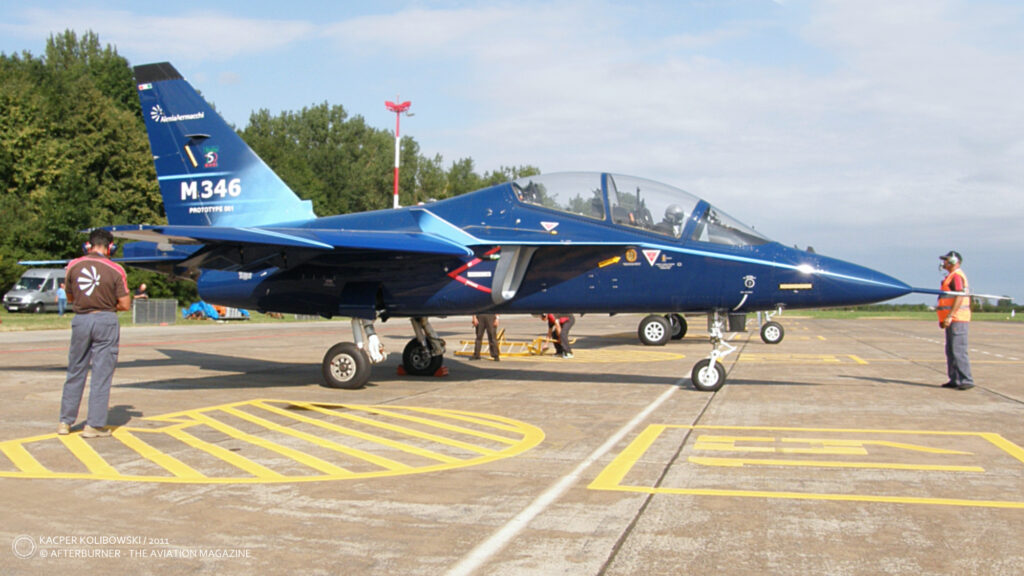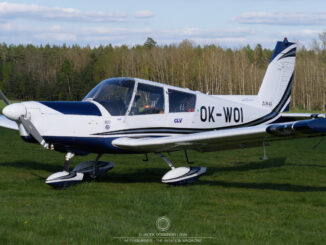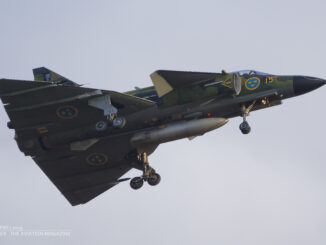 Leonardo/Alenia Aermacchi M346 Master (c/n 6962/001, CPX615, the 001 prototype of the aircraft) taxiing for flying display during International Air Show 2011, Radom, August 2011.
Leonardo/Alenia Aermacchi M346 Master (c/n 6962/001, CPX615, the 001 prototype of the aircraft) taxiing for flying display during International Air Show 2011, Radom, August 2011.
The history of the M346, being the Europe’s most advanced training jet aircraft, began in the mid-1980s, when a programme called New Technology Trainer (NTT) was launched to develop a new European military training aircraft. The project involved manufacturers from Germany – Dornier and DASA (Deutsche Aerospace AG), France – Dassault Aviation, and Italy – Aermacchi.
In 1985, a cooperation agreement was established within the NTT that resulted in the initial concept of the aeroplane, which had to be a single-engine jet aircraft with an empty weight of 4,500 kg. Four years later, the NTT initiative was succeeded by another programme, known as Advanced Trainer 2000 (AT-2000).
This time, however, the programme included Diehl Aerospace from Germany, Saab Group from Sweden and Hellenic Aerospace Industry from Greece, as well as the aforementioned Dassault and Aermacchi companies, as main contributors to the AT-2000 project. The first conceptual project of the new aeroplane was proposed by Aermacchi that suggested it should be a twin-engine training aircraft. However, the Italian design failed to gain recognition and was shortly rejected. In consequence of further joint development, the companies participating in the project created an aircraft known as Mako HEAT (High Energy Advanced Trainer).
The Mako HEAT had to be a two-seat aircraft with an empty weight of around six tonnes. Powered by a single General Electric F414M turbofan engine with afterburner, the aeroplane was supposed to be capable of flying at supersonic speeds. It’s worth to mention, that at the same time, also a single-seat combat version of the aircraft was under development, designated Mako LCA (Light Combat Aircraft).
It was planned that – in the event of further development and serial production of the Mako aircraft – wings and fuselage elements would be manufactured at Aermacchi. However, taking into account significant differences between the Mako and the aforementioned initial concept proposed by the Italian company, Aermacchi decided to withdraw from the programme of joint European trainer.
As a consequence, works on the jet within the AT-2000 had slowed down significantly and eventually the programme was cancelled in 2009. The Mako HEAT ended up only as a full-scale mock-up.After leaving the AT-2000 programme, the Italian company turned its attention towards Russia and its efforts to find a replacement for L-29 Delfín and L-39 Albatros trainers of Czechoslovak origin.
In Russia, almost a decade had passed from the time its authorities opened a competition for the new training jet for the Russian Air Force. It was responded by all leading aircraft design bureaus that proposed their concepts – Sukhoi S-54, Myasishchev NUTK (M-200), MiG-AT and Yakovlev Yak-UTS.
The competition was intended to be finished in December of 1991 and, according to some sources, the Myasishchev NUTK had to be the winner, with MiG-AT placed second and Yak-UTS the third. Nevertheless, financial and political issues caused significant delays in the programme and resulted in Myasishchev withdrawal from the contest in May of 1992.
The MiG-AT was the first joint aircraft design made in cooperation between the Russian and Western companies. The Mikoyan construction bureau established cooperation with several French companies and, in the result, the MiG-AT final concept was similar to the Alpha design (please refer to our article from March 2020 for further details).
The aforementioned fact had not gone unnoticed by Aermacchi that had offered the Yakovlev bureau, the second participant of the new contest, to work together on the new trainer. It is important to highlight that the Yakovlev design, in its assumptions, was almost identical to the Italian concept of the European trainer – the one proposed and then rejected within the AT-2000 programme. Eventually, in 1993, Aermacchi and Yakovlev agreed to jointly develop the new Russian jet trainer that received its new designation Yak/AEM-130.
The cooperation between the Russian and the Italian aircraft manufacturers seemed to be mutually beneficial. Yakovlev was expecting to receive an additional financial injection to the project, use the Italian know-how to modernize the design and, eventually, to find new customers in the Western countries. On the other hand, Aermacchi gained access to Russian aerodynamic solutions and technology, as well as decreased manufacturing costs.
Despite the freezing of the competition, development of the MiG-AT and Yak/AEM-130 was continued. The MiG trainer performed its maiden flight in March of 1996, followed by Yak-130 in April of the same year. Finally, in 2002, the contest for the new Russian jet trainer was opened again.
That successful and fruitful collaboration survived until 1998. That year, due to continuous lack of fundings from the Russian side, the Yak/AEM-130 project started to become increasingly one-sided venture. In addition, there was no agreement on adapting the co-designed aircraft to requirements of Western customers. As the consequence, in July of 2000, the Aermacchi company withdraw from the joint development, buying back the Yak/AEM-130 technical documentation for 77 million USD.
Although the companies parted ways, development of the new trainer continued – although separately. With the technical documentation bought from Yakovlev, the Italian company was able to create its own training aircraft on its basis. In turn, the amount received allowed the Russian company to continue works on its aeroplane that finally became the Yak-130 trainer jet.
The first prototype of the Italian trainer, now officially designated the M346 Master, was rolled out on 7th June 2003. That aircraft was intended for static test and then followed by the prototype No. 001. On 15th July 2004, the latter successfully performed its maiden flight.
Soon, the M346 began to gain international interest and its development gained momentum. In January 2005, the Italian company signed a Memorandum of Understanding (MOU) with the Greek Ministry of Defence, which thus became partner in the programme. This resulted in commencing manufacturing cooperation between Aermacchi and Hellenic Aerospace Industry a year later.
In March 2008, during Feria Internacional del Aire y del Espacio air show in Chile, Alenia Aermacchi signed a cooperation agreement with Chilean ENAER aerospace manufacturer. On 10th April of the same year, the first Low Rate Initial Production (LRIP-00) example of the M346 was manufactured, equipped with a new undercarriage, new airbrake and having more composite elements. In May 2008, Alenia Aermacchi signed an agreement with another partner, the Boeing company, to provide marketing, sales, training and technical support partnership for the M346 and M311 – two-seat military trainer, earlier developed by Aermacchi from the SIAI Marchetti S.211, to complement the M346.
On 20th July 2011, the M346 Master received Military Type Certification by the General Directorate for Aeronautical Armaments of the Italian Ministry of Defence. In the following years, further versions of the aircraft were being developed, including the combat-capable M346 LCA (Light Combat Aircraft), M346FA (Fighter Attack), M346FT (Fighter Trainer) and M346LFFA (Light Fighter Family of Aircraft) adapted to perform additional operational duties, such as close air support and air policing.
Currently, besides Italy, the M346 Master aircraft are used in trainer and combat-capable versions by the air forces of Greece, Israel, Poland, Qatar and Singapore. In addition, they have also been ordered by Azerbaijan, Nigeria and Turkmenistan.
In conclusion it is worth to say that the M346 Master aircraft was also officially selected by the United Arab Emirates Air Force at the IDEX 2009 defence show in Abu Dhabi in February 2009. The UAE was interested in acquiring 48 Masters, but negotiations stalled due to specification issues in January 2010.
In November 2011, however, the M346 Prototype 001, participated in the Dubai Air Show. On 18th November, shortly after taking off on the way back to Italy from the aforementioned air show, the aircraft crashed near Palm Deira, Dubai. Fortunately, both crew members, Captain Giovanni Bingley and Butch Corino managed to eject safely.
Thus, our photo of this aircraft presented in this Photo of the Week, taken just a few months earlier, in August 2011 when this aircraft visited the International Air Show 2011 in Radom, Poland, is probably one of the last photos of this particular aircraft, the first flying prototype of the M346 Master.



